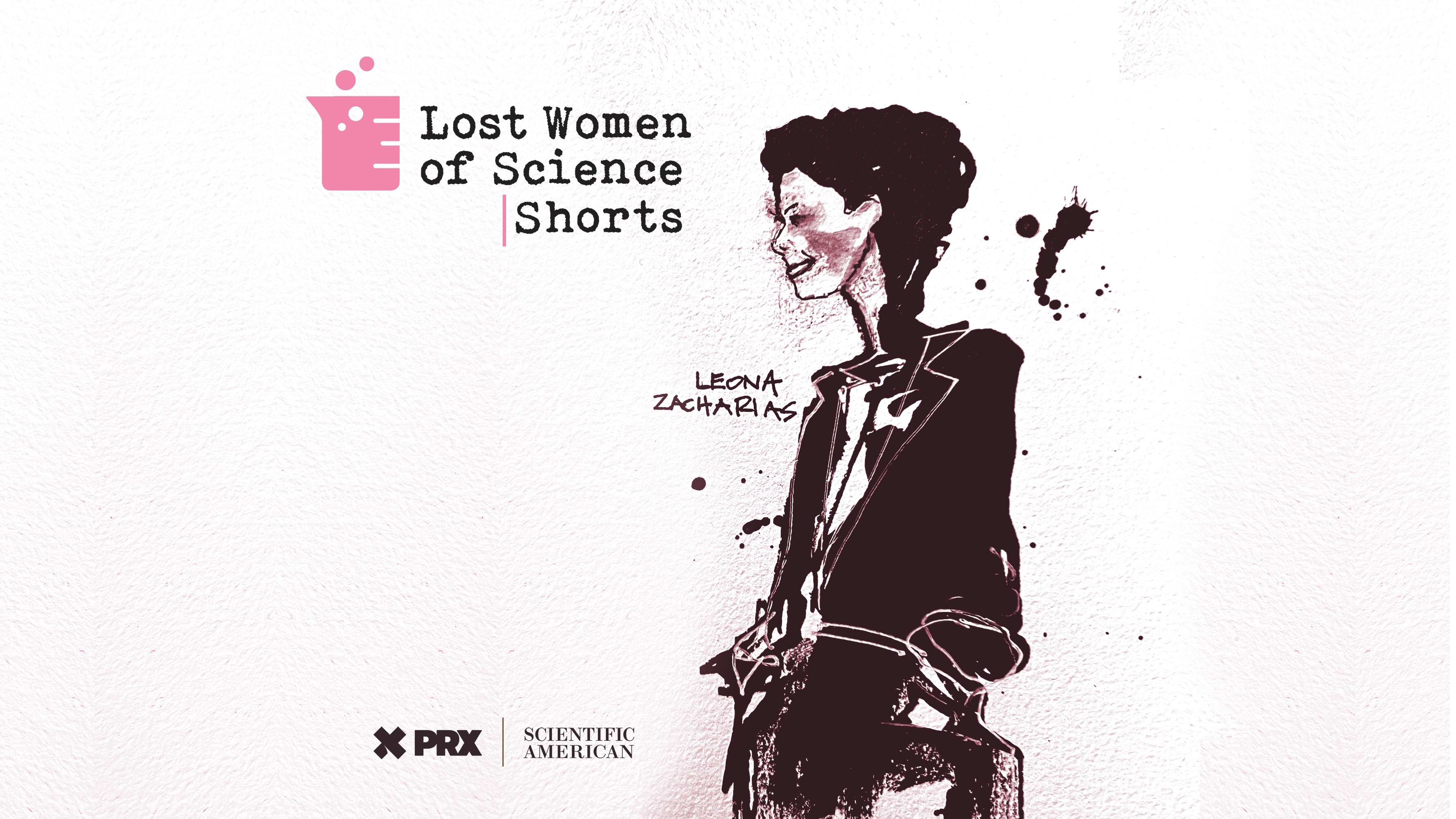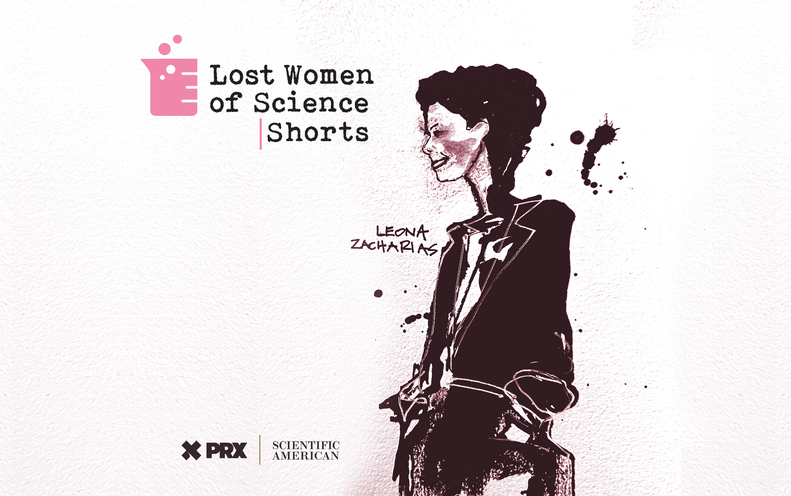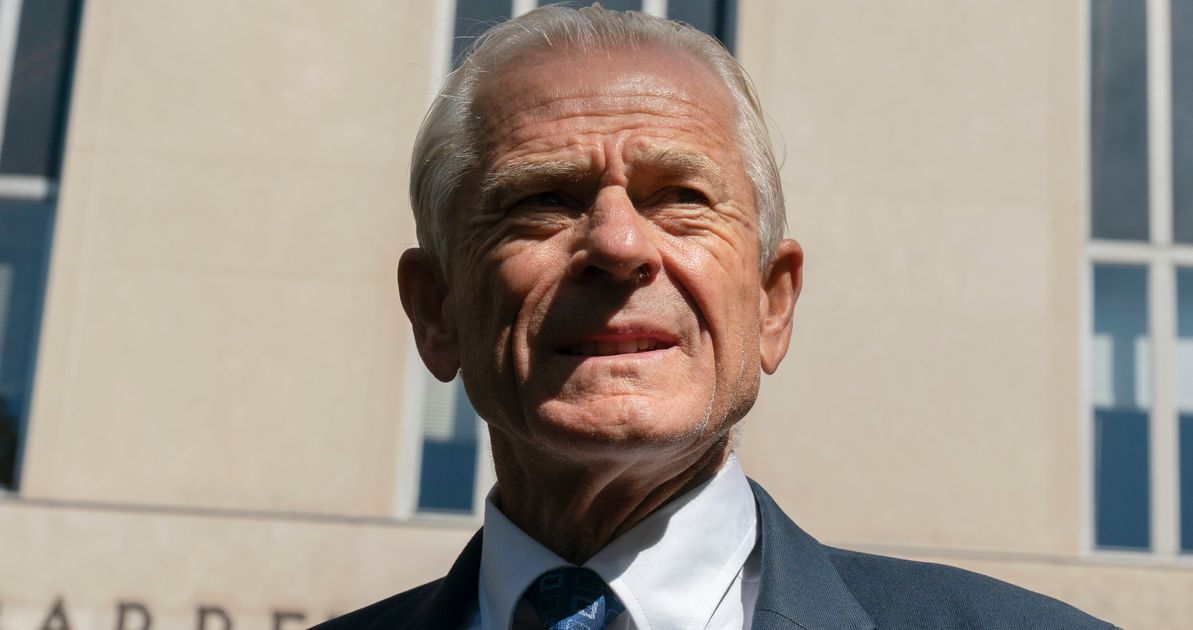
Scientist Leona Zacharias was a rare woman. She graduated from Barnard College in 1927 with a bachelor’s degree in biology, followed by a Ph.D. from Columbia University. But throughout her career, she labored behind men with loftier titles who got the bulk of the credit. In the 1940s, when premature newborns were going blind after being born with perfectly healthy eyes, Zacharias was part of the team that worked to root out the cause.
In this inaugural episode of Lost Women of Science Shorts, host Katie Hafner visits the archives at the Massachusetts Institute of Technology and Massachusetts Eye and Ear in Boston to try to understand Zacharias’s role in solving the mystery. For Hafner, it’s personal: Leona Zacharias was her grandmother.
LISTEN TO THE PODCAST
EPISODE TRANSCRIPT
NIMESH PATEL: They didn’t realize that was likely a late stage of a retinal detachment and permanent vision loss.
KATIE HAFNER: I’m Katie Hafner and this is Lost Women of Science Shorts. Today we’re going to hear about a race to figure out why premature babies were going blind in the 1940s. It’s part of our new series of 30-minute shorts and in this, the inaugural episode, I’m exploring a scientist who was deeply involved in finding the cause of that affliction. It’s a woman with whom I have an emotional connection that’s… let me just say…complex. My maternal grandmother, Leona Zacharias.
When I was growing up, I knew in some vague way that my grandmother was a scientist or had been a scientist. But it was my grandfather’s career I’d been taught to be familiar with. Jerrold Zacharias was a prominent nuclear physicist, a science advisor to President Eisenhower, and he developed the first atomic clock. His work was the stuff of family lore. Hers? It didn’t come up.
Until recently, I had no idea that she had a Ph.D, a singular accomplishment for a woman back in the 1930s. And it would be many years before I learned she played a central role in solving that tragic puzzle of the babies going blind nearly 80 years ago. But before we get to the science, I want to tell you a little bit about my grandmother.
Leona Zacharias was not a warm and fuzzy woman. Oh no. She was austere, imperious, quick to judge, stingy with affection. I spent my childhood living in fear of her. Her knife-sharp edges sliced their way through the generations of my family. What made her seem so angry?
She loved dogs more than people, or so it seemed to the humans in her life. She owned a succession of standard poodles, and as a Mozart aficionado, she gave her dogs names such as Lorenzo, Papageno, Cherubino. Every morning she would cut toast for them into perfect small squares. When we were visiting, my sister and I would fight over the privilege of tossing the morsels into the air for the dogs to catch, seeking our grandmother’s hard won approval by way of her beloved dogs.
Now for the plot twist.
I do have a single sweet memory of my grandmother. I was seven, maybe eight. It was summer and we were visiting my grandparents in suburban Boston, and I woke up one morning with conjunctivitis. Both my eyes were nearly crusted shut, and it was my grandmother who treated my eyes, twice a day. She applied ointment with incredible tenderness and gentleness. She held my hand and talked my fears away. I was so comforted and I was a little confused. It was truly out of character. So what was all that about?
Recently, just out of curiosity, I googled my grandmother’s name, Leona Zacharias. And there she was. The MIT Distinctive Collections had her papers in its archive. I knew she worked there later in her career. Distinctive Collections? I just had to go there.
THERA WEBB: My name’s Thera Webb. I’m the project archivist for the Women at MIT Initiative at MIT.
KATIE HAFNER: It’s Thera’s job to bring to light women at MIT who did important science and somehow went missing. She leads me to a small room at the campus archives and there, she pulls a box of files from the collection. When I see the box, my heart skips a beat. I’ve been digging into the work of unsung female scientists long enough to suspect that my grandmother might have done something really significant. I want to dive right in.
THERA WEBB: I just ask that you take one folder out at a time, so that you don’t, sort of, get things mixed up. Our folders are numbered, but it’s always easier to have something…
KATIE HAFNER: The first thing we pull out of the box is my grandmother’s CV. It’s four pages, an impressive blur of jobs and scientific papers and academic degrees, starting with her graduation from Barnard College in 1927.
But Leona Zacharias’s life began 20 years earlier when she was born Leona Ruth Hurwitz in New York City, to a middle-class Jewish family with Eastern European roots. Her father was a hard-working math teacher. There was never any question about whether she would attend college, and her parents encouraged her to pursue a career, which was very unusual advice to give to a young woman at the time.
In 1925, when Leona was a sophomore at Barnard, she met my grandfather, Jerrold Zacharias, a senior at Columbia across the street, who was studying physics. He was from Florida, and that was exotic. He was funny, and charismatic, and wealthy. They made a handsome pair. In an arresting photo I saw for the first time only recently, they’re standing in profile looking affectionately at each other.
She has classic chiseled features. I’d have to describe her beauty as daring. In that photo her hair is cut almost as short as his. Not your usual 1920s bob, and she’s ahead of the fashion curve in a slouchy suede trench coat that falls just below her knees. And she’s wearing slacks. In the 1920s. And my grandmother looks so happy in that photo, a look I don’t recall seeing on her face in all the years that I knew her.
Two weeks after Leona graduated from Barnard with a degree in biology, she married Jerrold. She was 20. Within a few years, they had their first daughter, my mother, and even then, Leona stayed on the path laid out for her by her parents. The CV shows that within her first decade of marriage she had earned a master’s degree in zoology, followed by a Ph.D. in anatomy, both from Columbia.
Just for context: in 1936, my grandmother was the sole female research fellow at Columbia. A couple of years later, of the 54 science Ph.D.s awarded, 8 went to women, and she was the only woman to receive a Ph.D. in anatomy. Still more impressive, a prominent science journal published her Ph.D. dissertation.
And in one especially energetic burst early in her career, she held three jobs simultaneously: research assistant at the American Museum of Natural History, anatomy instructor to medical students at Columbia and, in the evenings, she taught classes at Hunter College. All this while being mother to a young child, and faculty wife to a rising star in the Columbia physics department.
She kept working through the birth of a second daughter in 1942 and a few years later, when my grandfather was tapped to join the physics department at MIT, my grandmother and the two girls followed him to Boston. From the dates on the CV it looks like she had no trouble landing a job almost instantaneously as a lecturer in ophthalmic research at Harvard Medical School. It was a job that would define her career.
On that CV I also see a lot of references to something called retrolental fibroplasia.
What on earth is that? It turns out it was a disorder that would upend the lives of thousands of families around the world.
In the 1940s, all through the medical community, there was talk of premature babies going blind shortly after being born with perfectly normal healthy eyes and no one knew why. The first case was documented on February 14th, 1941, when Dr. Stewart Clifford, a Boston pediatrician, made a routine home visit to examine an infant girl, born prematurely, three months earlier. Although the baby’s general development was excellent, he was shocked to see that the baby’s eyes were opaque and they were jerking abnormally from side to side, a phenomenon whose medical name is nystagmus. The baby had gone blind.
Over the next several years, as more and more cases surfaced that resembled Dr. Clifford’s patient, physicians came to understand that this was not a one-off. It was an epidemic, and one that reached far beyond Boston. But as always happens when a new disease emerges, physicians and scientists began asking: Why now?
Dr. Nimesh Patel is a pediatric ophthalmologist at the Massachusetts Eye and Ear Infirmary in Boston. He says that before the 1940s, many premature babies simply died.
NIMESH PATEL: The neonatal survival was not that good. So only in the 1940s, these industrialized countries started having better neonatal survival. So they started encountering a problem they had never seen before.
KATIE HAFNER: Once incubators came into widespread use, premature, very low birthweight babies were staying alive. Unlike many diseases that disproportionately affect poor patients, one of the mysteries of this was that it seemed to be hitting affluent areas especially hard. Where these more advanced interventions were available, doctors were seeing more cases of this blindness.
NIMESH PATEL: So in the 1940s it was first described as retrolental fibroplasia.
KATIE HAFNER: Which literally means a proliferation of fibrous tissue behind the lens.
NIMESH PATEL: They didn’t actually understand what they were even seeing at that point. They just saw a membrane behind the lens, but they didn’t realize that was likely a late stage of a retinal detachment and permanent vision loss. So the work that was going on here was more just characterizing the disease and trying to figure out what’s going on, and that was really important.
KATIE HAFNER: In other words, it was a mystery not unlike the Thalidomide crisis a decade later in the 1950s, when doctors were seeing newborns with deformities unlike anything they’d encountered before. When it came to this infant blindness in the 1940s, scientists were similarly baffled. Retrolental fibroplasia was a frightening mystery that was being studied especially closely in Boston in 1946 just as my grandmother arrived to work at Mass Eye and Ear. By the late 1940s, the syndrome had exploded into a full-blown epidemic.
In one famous case, in 1950, an African-American baby named Stevland Hardaway Judkins was born six weeks early in Saginaw, Michigan. Soon after birth, he was diagnosed with retrolental fibroplasia, which led to permanent blindness. Luckily this didn’t dampen his musical genius. You may know him as Stevie Wonder.
Like Little Stevie Wonder, thousands of children around the world would lose their eyesight. And now as I’m sitting at MIT leafing through my grandmother’s files, I’m thinking, Hmm, did she play any role in figuring out the cause?
Whatever she did, she did it with one hand tied behind her back. Because according to the job titles on her CV, despite her Ph.D., it looks like she never advanced much beyond the associate level throughout her career.
KATE ZERNIKE: I think this is a really common thread that runs through the early history of women in science.
KATIE HAFNER: That’s Kate Zernike, author of The Exceptions, a new book about how female scientists fought for fairness at MIT in the 1990s.
KATE ZERNIKE: So, and this is true of women in the fifties, even, so, so, you know, 20 years beyond your grandmother, the opportunities for women were so limited, that if they could have a position somewhere, the culture was such that they just felt lucky. They felt lucky to be there. They felt like the university was, or the institution, if it’s Mass Eye and Ear, was doing them a favor in some way.
I think it’s a really different mindset than we can even imagine so many decades later. But you hear this over and over from women – they just felt really lucky to have any job at all.
KATIE HAFNER: Without equal status of any kind, my grandmother was nevertheless diving headlong into her work on Retrolental Fibroplasia, all while being the good MIT faculty wife, hosting dinner parties for junior faculty, going to cocktail gatherings, and carrying out any number of domestic duties. Plus, her younger daughter was still under her roof, and that daughter was a teenager.
In the meantime, her husband, my grandfather, was being celebrated with all sorts of recognition. Through it all, she’s publishing a bunch of papers, right through the 1950s, and she presented at least one of them at an ophthalmology conference.
The more I see, the prouder I am of my grandmother, and I find myself rooting for her in that kind of black-and-white, let’s-find-a-hero kinda way. I’m now hoping to discover in all of this that she, in fact, is the one who discovered whatever was causing the blindness.
Then, from the collection, I pull out a paper. It stops me cold.
DOMINIQUE JANEE: I’m Dominique Janee, Production Assistant at Lost Women of Science, and we’d like to invite you to share information about scientists whose stories deserve to be told. Starting February 9th, you’ll hear listeners tell stories in their own words. We’re calling it From Our Inbox. So if you know someone who should be featured, go to our website and hit the “get in touch” tab. Or you can reach out on social: we’re lostwomenofsci on Twitter, Instagram, Facebook, and TikTok. That’s lost women of S, C, I.
KATIE HAFNER: Ok so in folder 32, Thera and I are looking at a paper, Advances in Pediatrics, Volume Three, 1948, and it’s just called “Retrolental Fibroplasia” by T.L. Terry, Boston, Massachusetts. Written in red is my grandmother’s name, Leona Zacharias. And then somebody named Everett wrote, “with best wishes to the real author.”
What on earth did this mean? And who is Everett?
To understand any of this, first I had to understand how all these characters are related. The sole author of that paper, T.L. Terry, was a prominent ophthalmologist at Mass Eye and Ear. He led the lab that my grandmother went to work for in 1946.
Terry is the one who gave retrolental fibroplasia its name. His role was so central from the start that the disease was also known as Terry Syndrome. Terry died shortly after my grandmother arrived at Mass Eye and Ear in 1946. And this article with his name on it appeared two years after that, in 1948.
Does that mean my grandmother actually wrote Terry’s paper? Did she finish it posthumously, or possibly edit it? Why would this man named Everett-somebody, whoever he was, make a point of naming my grandmother the real author?
A quick scan of the paper tells me it’s a definitive history of retrolental fibroplasia and it gives a full report on what was known about the disease to date, as well as some speculation as to its cause. Could it be due to something hereditary? Gestational illness? Infection? The thinking was all over the place.
My search for answers leads me to the very building where my grandmother had her office in Boston at Mass Eye and Ear. As I’m in the elevator, I try to envision which office she might have had, and the name Leona Zacharias etched into a brass plate at the door. It’s like chasing a ghost, and I’m not alone. Mass Eye and Ear, like MIT and a lot of institutions these days, is revisiting its history with an eye toward what, or rather who, is missing.
VANESSA FORMATO: This really was a great time for you to be doing this because I’ve been looking into the history of women and people of color at Mass Eye and Ear.
KATIE HAFNER: That’s Vanessa Formato, the archivist at Mass Eye and Ear.
VANESSA FORMATO: You know, we’ve really just been kind of looking through our records, trying to figure out what we have, and we had discovered some files about Dr. Zacharias.
KATIE HAFNER: Vanessa wheels in a library cart and on it is a stack of elegant quarter bound leather volumes covered in gold veined marbled paper. They’re Mass Eye and Ear annual reports, each containing the entire “who-did-what” for each year.
VANESSA FORMATO: So these are actually collections of our annual reports. More or less since Mass Eye and Ear was founded in around 1824, we’ve been publishing annual reports from the different departments and laboratories. Let me see if I can find where the, the, Howe Lab one is in here.
KATIE HAFNER: Oh, that crinkly sound. While she’s looking for the reports that mention my grandmother, that’s what I’m struck by – the sound of the pages being turned in one of the hundred-year-old books. But I can’t shake the question on my mind about retrolental fibroplasia.
VANESSA FORMATO: So these are great records, not only of who worked at the hospital, but also sort of the activities and Dr. Zacharias’ work was reported on, in quite a few of these actually.
KATIE HAFNER: What do you know about who figured out the cause?
VANESSA FORMATO: Interestingly, when I first clued into Dr. Zacharias in our collection, um, our library director sort of did a quick search to see what papers she could find by Dr.
Zacharias, and she found an early one, I believe, dated around 1949 that actually proposed what the possible causes could be.
KATIE HAFNER: I think we’re getting somewhere… Vanessa leaves me to the annual reports, and in the very first one, I find a summary of that 1949 paper Vanessa mentioned. It was published just as the blindness epidemic was starting to peak. There’s my grandmother’s name as co-author.
The first author was V. Everett Kinsey. That’s the Everett who scribbled the note, “best wishes to the real author” on the Terry paper, the year before. Okay, one mystery solved.
And Vanessa’s right: Zacharias and Kinsey published a compendium of possible causes: birth order; the sex of the baby; iron; vitamin A; and oxygen, which is given routinely to premature babies with underdeveloped lungs.
It’s evident that after Terry’s death in 1946, Everett Kinsey took over the lab and he was my grandmother’s boss. Also evident is the fact that Kinsey and Zacharias became a real team.
Also in the archive are several large black and white photographs of the blind children themselves. Children my grandmother is likely to have met. The photos are heartbreaking.
I’m paging through the reports chronologically, each of them detailing the work done to date and most of them signed by my grandmother. There is her familiar handwriting, right in the archives, meticulously – almost obsessively – charting and graphing and tracking every variable that might show a pattern that could explain why these babies were going blind. In one experiment, she tested the effects of Vitamin E deficiency on baby chicks.
I realize I’m peering through a retrospectroscope, watching in something resembling real time, as scientific research with all its trial and error is carried out. And this one is like any other scientific discovery. It’s rarely one person who pulls something out of thin air. There are small gains here, missteps there. Things that seem promising and turn out to be wrong. This is giving me a window into the process of basic science. In this case, a single physician sees a disease which launches years of clinical observation, epidemiology, research done by multiple people in multiple places, until pieces of the puzzle begin to fall into place.
History tends to simplify all of this by attributing a scientific breakthrough to one person, usually a man, but whoever that was relied on a multitude of foundational parts. And it’s becoming clear that my grandmother’s many years of probing, constituted one of those parts.
Since retrolental fibroplasia was hitting premature infants in developed countries all over the world, rooting out the cause became a worldwide collaboration. By 1953, researchers in at least a dozen different places were sharing their findings, which was a real logistical challenge. All hard copies and stamps on envelopes back then.
Gradually, the data coming in from all these places began to point to the unlikeliest of culprits: oxygen. In the United States, England, and other developed countries, incubators were growing more sophisticated, allowing for higher levels of oxygen concentration, and that, it turned out, was the problem.
NIMESH PATEL: It became clear that it was really premature babies, but also those who were getting a lot of oxygen.
KATIE HAFNER: That’s Nimesh Patel, the pediatric ophthalmologist, again.
NIMESH PATEL: And what happened was that people found that if you had too much oxygen, the blood vessels weren’t growing normally in the back of the eye.
It was almost like the eye said, ‘I don’t really need blood vessels cuz I’m getting all this supplemental oxygen’. And then as a secondary cause, once the oxygen is pulled away, now the eye tries to make new blood vessels and it can actually pull on the retina and cause a detachment.
KATIE HAFNER: This was figured out in 1955. And the lesson was sobering. Oxygen? It was something that seemed so obviously benign. Not giving enough oxygen could be dire for preemies with undeveloped lungs. And remember, there was no easy way to measure a baby’s oxygen level in order to calibrate the amount given. So it made perfect sense to give premature babies a lot of it. As soon as new standards were put in place and once oxygen levels were reduced, the incidence of the disease decreased sharply.
So I text my aunt Johanna, who we call Joey. She’s the younger of Leona’s daughters. I tell her a bit about what I’ve been up to. Does she know all about her mother’s work? Indeed, she does. She mentions the Lasker award. What?
The Lasker. It’s the highest prize awarded in the United States for contributions to medicine, and in 1956, the Lasker was awarded to two men. One was an ophthalmologist at Johns Hopkins named Arnall Patz, and the other was Everett Kinsey.
My aunt and I get on a Zoom call. We do the usual fiddling around with the speakers and the headphones.
KATIE HAFNER: Hold on a sec… Can you hear me?
JOHANNA ZACHARIAS: Yeah.
KATIE HAFNER: Okay, good. Uh, I’m gonna record…
AUTOMATED VOICE: Recording in progress.
JOHANNA ZACHARIAS: Oh, there she is. She makes me wanna make a right turn.
KATIE HAFNER: I quickly get down to business. I ask her what role she thinks my grandmother might have played in unearthing the cause of this blindness.
JOHANNA ZACHARIAS: I’m gonna be a disappointment here, but I don’t know.
KATIE HAFNER: No, I don’t know either.
JOHANNA ZACHARIAS: She didn’t tell me anything ‘cause I didn’t think she assumed I would never understand anything, which was reasonable.
KATIE HAFNER: My aunt describes what she can remember about my grandmother as a working scientist.
JOHANNA ZACHARIAS: I don’t know how passionate she was about it, but she always did it. She had a white lab coat that said MEEI on it. She never worked full time. She always worked, I think three days a week.
KATIE HAFNER: My aunt tells me about a trip she and my grandparents took to England in 1954 just as scientists were homing in on oxygen as the culprit. While they were there, Leona went to visit a hospital with surprisingly unsophisticated equipment. Not an incubator in sight, despite their widespread use in England.
JOHANNA ZACHARIAS: I remember her visiting Oxford taken around a ward where preemies were not in incubators. They were in little beds. And one of the things Leona commented on was that the little beds were adorable, she said, and that each little tiny, tiny baby was in a bed with sheets and pillows and little blanket, and the English bolster under the pillow. You, you know about the bolster?
KATIE HAFNER: No…
JOHANNA ZACHARIAS: It was a wedge…
KATIE HAFNER: As I listen, I wonder what might have made Leona take special notice of these little beds, and I’m reminded of the photos of the blind children I saw at Mass Eye and Ear.
Joey, they are just heartbreaking. These blind kids.
JOHANNA ZACHARIAS: Well, they have these funny, sunken, underdeveloped eyes.
KATIE HAFNER: Tell me if you think I’m projecting this on her, which I might well be, but her heart must have really gone out to the kids and to the families.
JOHANNA ZACHARIAS: Katie, I have to say that was not evident. It may have happened, but I, I didn’t perceive it. Oh I’m just saying that they were subjects. If she could have done something for them, but she couldn’t.
KATIE HAFNER: Mmhmm.
JOHANNA ZACHARIAS: She was studying them. Not treating them.
KATIE HAFNER: Arnall Patz, the ophthalmologist who shared the Lasker award with Kinsey, went on to become famous in his field, and it turns out that my aunt was about two decades ahead of me.
About 20 years ago, she went to Johns Hopkins to talk to Patz. After all, her mother worked in the lab of his Lasker Prize co-winner, Everett Kinsey. She remembers Patz repeating what was by then well-known.
JOHANNA ZACHARIAS: He was very clear about his conclusion that where hospitals were affluent enough to take care of, of these preemies with a lot of oxygen is where the incidence was high and in lesser places it didn’t show up.
KATIE HAFNER: And then when you told him, Do you remember my mother…
JOHANNA ZACHARIAS: Leona Zacharias, and I think I had to spell it. He hadn’t a clue who she was. He was unaware of her existence.
KATIE HAFNER: And when you said, so you must have said, Oh, she worked with Kinsey…
JOHANNA ZACHARIAS: And then he said, ‘I bet she did all the work he got credit for’.
KATIE HAFNER: Oh, gosh, golly.
Is it actually possible? Kinsey never told Patz about my grandmother’s contributions, even after publishing several papers with her and acknowledging her role with his “Best wishes to the real author” inscription?
Here’s Nimesh Patel again.
NIMESH PATEL: I think there is a lot of this. I’ve read some of the original papers, and some of them were published as a single author. And they’ll put sometimes their secretaries in the acknowledgements, but it was actually their secretaries who were responsible for combing through the whole data set, writing everything down, logging all the cases.
Nowadays that would even get you a dual authorship or a first author on a paper. But back in the day, oftentimes the senior doctor was publishing these papers under their name with an acknowledgement to their secretary who was really doing a large chunk of the work.
KATIE HAFNER: My grandmother wasn’t a secretary. She was more than qualified to work shoulder-to-shoulder with her male colleagues.
MICHAEL REPKA: Oh, with best wishes to the real author. Wow.
KATIE HAFNER: Everett Kinsey. Yeah.
MICHAEL REPKA: Wow.
KATIE HAFNER: That’s Dr. Michael Repka, Professor of Ophthalmology at Johns Hopkins. I wanted to know what he thought of the inscription on the paper credited to T.L. Terry.
MICHAEL REPKA: Well, they said Terry was sick, so I’m guessing he had a deadline and needed the paper written. How did this version of this paper is? Was this in their archives?
KATIE HAFNER: Mm-hmm. It was.
MICHAEL REPKA: Or… Oh, wow.
KATIE HAFNER: I know.
KATIE HAFNER: After talking to Dr. Repka, I go back to the paper itself. I’ve already read it as a scanned PDF, but this time I print it out to take a closer look. And there at the bottom of the front page, in a small typeface is a tiny star. It’s asterisk, then this, quote, “Edited after Dr. Terry’s death by a committee.” The first name listed on that committee: Dr. Leona Zacharias.
There’s her credit. So yes, she was acknowledged. But in the end, that asterisk is a metaphor for the way many women’s contributions in my grandmother’s era were acknowledged. Yes, it’s there if you look hard enough. At the bottom of the page. In a small font. And here’s what’s true: It’s not the asterisk people who are asked to give speeches. It’s not the asterisk people who get tenure and promotions, who become deans or department chairs or even full professors. Even the fact that I missed that tiny asterisk the first time I read the paper is all part of that metaphor.
Retrolental fibroplasia is now called retinopathy of prematurity, or ROP, and contrary to what you might think, definitely contrary to what I thought, it’s still a problem. In the developing world, where access to advanced care isn’t readily available, ROP is one of the leading causes of childhood blindness. And in developed economies, it’s a constant concern because of the latest advances in neonatal care.
NIMESH PATEL: Babies are so young and born much earlier and surviving, their oxygen requirements to keep them alive are much higher. So before you could turn the oxygen down on a 28 week baby and they still may survive, well if you have a 22 week baby with a lot of other problems, heart disease, lung, disease, you can’t turn the oxygen down. I still have patients in the NICU who are on high flow. They’re intubated, and so that really requires a lot of screening and treatment to keep their eyes intact.
KATIE HAFNER: There’s no disputing that my grandmother played a crucial role in the basic, often plodding science that led to the discovery of the cause of ROP. But what about the complicated woman who was my grandmother? Well, I’m left with a lot of complicated feelings. Daughters often know their mothers best, so I turned to hers, my Aunt Joey.
On that Zoom call we had, I told my aunt how terrified I had been of her mother when I was a child.
JOHANNA ZACHARIAS: She was a pretty terrifying woman. You were right to be terrified.
KATIE HAFNER: I do have to tell you one quick story though . When I was a little girl, maybe seven, I got conjunctivitis. And she, in the most tender way, administered the ointment to my eyes.
JOHANNA ZACHARIAS: Absolutely. I can picture it, I can feel it, Katie.
KATIE HAFNER: Really?
JOHANNA ZACHARIAS: Absolutely. I mean, she was at her tenderest because problem was your eyes
KATIE HAFNER: And she knew from eyes.
JOHANNA ZACHARIAS: And she knew from eyes. And, I can totally picture that, Katie. It really moves me.
KATIE HAFNER: Yeah, and it’s amazing how it’s etched in my memory to this day, I mean, I was tiny, and she was tender.
KATIE HAFNER: Leona Zacharias died in 1990, just shy of her 83rd birthday.
I’ll always treasure that singular childhood interlude of intimacy I had with her and now I can add to that the intense connection I felt during those two days while reading through her papers, when that closed fist of a person I knew seemed to be extending an open palm, inviting me into her brilliant mind.
You’ve been listening to Lost Women of Science Shorts.
Thanks to my co-executive producer Amy Scharf, Senior Producer Barbara Howard, and our sound design engineer D Peterschmidt. Thanks too to Jeff DelViscio, Meredith White, Bob Wachter, Mackenzie Tatananni, Nora Mathison, Dominique Janee, Mike Fung, Paula Mangin, Susan Kare, Elizabeth Younan, Joe Hiatt, Jacque Duncan, Johanna Zacharias, Thera Webb, Vanessa Formato, Mike Repka, and Stuart Fine. And special thanks to Dr. Alejandra de Alba, for taking time out of a busy day at the clinic to talk to me.
Lost Women of Science is funded in part by Schmidt Futures, and by The Alfred P. Sloan Foundation. This podcast is distributed by PRX and published in partnership with Scientific American. You can learn more about our initiative at lost women of science dot org or follow us on Twitter and Instagram. Find us @lostwomenofsci. That’s At Lost women of S, C, I.
I’m Katie Hafner.



























































